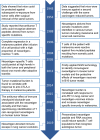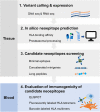Tumor neoantigens: from basic research to clinical applications
- PMID: 31492199
- PMCID: PMC6731555
- DOI: 10.1186/s13045-019-0787-5
Tumor neoantigens: from basic research to clinical applications
Abstract
Tumor neoantigen is the truly foreign protein and entirely absent from normal human organs/tissues. It could be specifically recognized by neoantigen-specific T cell receptors (TCRs) in the context of major histocompatibility complexes (MHCs) molecules. Emerging evidence has suggested that neoantigens play a critical role in tumor-specific T cell-mediated antitumor immune response and successful cancer immunotherapies. From a theoretical perspective, neoantigen is an ideal immunotherapy target because they are distinguished from germline and could be recognized as non-self by the host immune system. Neoantigen-based therapeutic personalized vaccines and adoptive T cell transfer have shown promising preliminary results. Furthermore, recent studies suggested the significant role of neoantigen in immune escape, immunoediting, and sensitivity to immune checkpoint inhibitors. In this review, we systematically summarize the recent advances of understanding and identification of tumor-specific neoantigens and its role on current cancer immunotherapies. We also discuss the ongoing development of strategies based on neoantigens and its future clinical applications.
Keywords: Immune checkpoint; Immune escape; Immunotherapy; Neoantigen; Resistance.
Conflict of interest statement
Henghui Zhang is an employee of Beijing Genecast Biotechnology Co., Beijing, China. The other authors declare that they have no competing of interest.
Figures
References
Publication types
MeSH terms
Substances
LinkOut - more resources
Full Text Sources
Other Literature Sources



